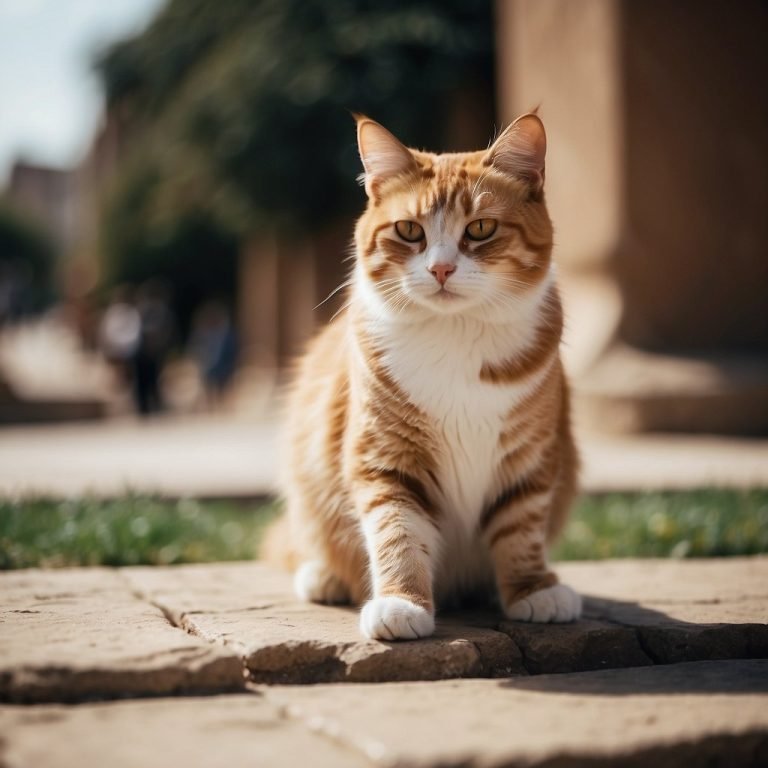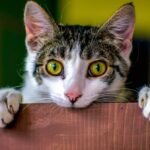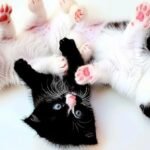The Fascinating History of Cat Domestication and Evolution: Paws and Reflect on Our Feline Friends 🐾🐱

The story of cat domestication is both charming and perplexing, much like the feline characters at its center.
As you may know, the bond between cats and humans stretches back millennia.
Digging into the past, it’s evident that cats sauntered into our lives in the Near East, with some experts suggesting this partnership began up to 12,000 years ago.
Though these creatures are now a common fixture in many households, their journey from wild hunter to beloved pet is filled with twists and purr-inducing turns.

Cats likely started their relationship with humans by acting as nature’s pest control, keeping rodents away from our ancient granaries.
It wasn’t a quick jump from wild to domesticated; rather, it was a gradual process, with cats slowly becoming accustomed to human presence.
The journey was as much about the convenience of having a warm, rodent-free place to sleep as it was about the development of a mutual affection.
Over time, cats have evolved not just physically but socially, adapting to human companionship while retaining their independent spirits.
Your feline friend’s ancestors embarked on a fascinating path of evolution.
What began with the African wildcat (Felis silvestris lybica) led to the diverse range of cat coats and personalities that warm our laps today.
The beauty of cat evolution is that it manages to reflect the changes in human society as well—after all, our histories have been intertwined for so long.
As our lifestyles changed, so did the qualities we valued in our whiskered companions, allowing for the wide spectrum of breeds and behaviors seen in cats across the globe.
The Origins of Cat Domestication
In tracing the journey of cats from wild predators to beloved pets, you’ll discover how early interactions with humans in the Fertile Crescent laid the foundation for the domestic cats we cuddle with today. 🐾
The Ancestry of Domestic Cats
Your modern-day house cat, curled up on the window sill, shares a lineage with the African wildcat, Felis sylvestris lybica.
This wild ancestor roamed the landscapes of Africa and the Near East, sporting a robust survival toolkit ideal for its environment.
Their genetic journey began around ten to eleven million years ago, branching into the Felidae family, with the domestic cat we know today branching off from there.
- Ancestral Roots: Felidae family
- Key Member: Felis sylvestris lybica
- Current Offspring: Domesticated cats
These wild roots are responsible for many of the playful and predatory behaviors you see in your feline friends at home. 😸
Early Domestication in the Fertile Crescent
Imagine the lush Fertile Crescent, the cradle of civilization; it’s here, amid the beginnings of agriculture, where humans and the wildcats of Africa and the Near East first forged their alliance.
Around 7500 BC, your cat’s ancestors began to associate with human settlements in Cyprus, drawn by the promise of ample prey like rodents that thrived in grain stores.
- Notable Location: Cyprus, Fertile Crescent
- Timeframe: Circa 7500 BC
- Reason for Bond: Control of pests
With this ecological partnership, humans found a natural solution to safeguard their food, and wildcats found a consistent food source and shelter.
This mutual benefit set the stage for a gradual and opportunistic journey toward full-blown domestication.
It wasn’t necessarily intentional at first, but over time, these early cat-like companions evolved into the affectionate and sometimes quirky domesticated cats that brighten your life today.
Cats in Ancient Civilizations
In the tapestry of history, your feline friends have always held a purr-ticularly special place in the heart of ancient civilizations, especially in Egypt where they attained divine status and across various cultures that embraced them for their grace and utility.
Egyptian Worship and Cat Mummies
In Ancient Egypt, cats were revered to the point of deification.
The goddess Bastet 🌞, often depicted with a lioness or domesticated cat head, was worshipped for her connections to motherhood and domesticity.
Your kitty’s ancestors were so adored that the death of a household cat warranted family mourning and elaborate ceremonies. Egyptian cat mummies 🏺 were not uncommon, with families wishing to provide their beloved pets with protection in the afterlife, much like their own.
These mummies have been discovered in significant numbers, signaling the cat’s high societal importance.
Feline Expansion Through Trade and Conquest
Cats likely spread throughout Europe and the rest of the world via ships 🚢, keeping rodent populations at bay and protecting valuable cargo.
This journey began in the Middle East and expanded as trade and conquest introduced the European wildcat lineage to new territories.
These early seafaring cats took on a role as both companions and vital pest controllers aboard vessels, which helped to establish their presence around the world.
Through this process, cats were domesticated as they adapted to new environments and civilizations, showcasing their incredible versatility and resilience.
Evolution and Genetics of Cats
Dive into the world of feline evolution and discover how genetic analysis sheds light on the journey from wild hunters to beloved pets. 🐾
Mitochondrial DNA and Genetic Analysis
Your kitty’s ancestors have a tale tucked within their DNA.
Genetic studies, including those looking at mitochondrial DNA, have traced the lineage of domestic cats back thousands of years. 🧬 Cats from different regions of the world have distinct genetic signatures.
For instance, an enlightening study by Claudio Ottoni and his team provided insights into the cat’s domestication by examining mitochondrial DNA from cat remains.
- Near East: The cradle of cat domestication, with genetic evidence suggesting a domestication process starting around 9,000 years ago.
- Egypt: Served as a hub for cat migration, with DNA indicating a second wave of cat domestication.
These genetic markers are invaluable in understanding how different populations of cats have evolved over time.
The Development of Different Cat Breeds
Each cat breed is a unique tapestry of genetic traits.
From the regal Siamese to the fluffy Persian, genetic variation is the artist behind their creation. 🎨 Their genetic makeup is often influenced by human selection for certain desirable traits, resulting in a fascinating variety of appearances and behaviors.
- Selective Breeding: Humans have favored traits such as coat patterns and temperaments, which play a significant role in the variety of cat breeds observed today.
- Genetic Studies: Tools like microsatellites aid researchers in mapping the genetic diversity of cat breeds, enhancing our understanding of their evolution.
As genetic and archaeological discoveries continue to surface, your furry friend’s past becomes ever more enthralling, contributing to the rich tapestry of the domestic cat’s history. 🐱💕
The Human-Cat Relationship
You’ve probably always known that cats hold a special place in the hearts and homes of many.
From their ancient roles as rodent patrollers to today’s beloved lap companions, cats have had a unique journey alongside humans.
Cats As Companions and Hunters
Your furry friend may now spend most of their days napping in sunlit corners, but cats were once prized for their prowess in controlling rodent populations.
The domestication process of cats was greatly influenced by their skill in hunting pests that threatened food stores in early agricultural societies.
- Early Companionship: Initially, cats were appreciated for keeping a check on rodents, but it wasn’t long before they were welcomed as companions.
- Mutual Benefit: Cats received shelter and food, which reinforced the relationship as beneficial for both parties.
Cats have maintained this practical aspect of their connection with humans throughout history, especially in rural settings where rodent patrol remains a valuable service.
Cats in Modern Societies
Nowadays, in places like U.S. homes and apartments, cats are more commonly seen as members of the family.
The American households‘ love for cats is evident, with millions of domesticated cats considered cherished pets.
This shift to seeing cats predominantly as companions reflects a significant change in the human-cat relationship.
- U.S. Homes: It’s estimated that a good portion of homes have at least one cat, with kitty’s presence often sought for comfort and friendship.
- Companionship vs.
Utility
: While the role of cats has transitioned more towards companionship, many cat owners can still appreciate their pet’s instinctive offers to keep the home free from pesky rodents.
Whether you’re a cat-owner or simply a cat-appreciator, the story of how cats became our beloved pets is as charming as the creatures themselves.
Remember, every purr and head-butt is rooted in a history that spans thousands of years! 😸🐾
Contemporary Issues and Future of Cat Domestication

As you cozy up with your favorite feline friend, it’s interesting to ponder the issues impacting their evolution today and what the future holds for these beloved creatures. 🐱
Selective Breeding: The pursuit of purr-fection through selective breeding has given rise to stunning cat breeds, from the luxurious Persian cat to the exotic Bengal and the regal Siamese.
But this pursuit also raises concerns over health and well-being, with some breeds prone to genetic health issues.
Natural Evolution: Aside from human-controlled breeding, house cats continue to evolve.
The classic tabby cat, for instance, may adopt new traits or behaviors that ensure its survival in a changing environment, both urban and rural.
| Concerns | Implications |
|---|---|
| Genetic Health | Increased predisposition to diseases in some breeds |
| Overpopulation | Stray cat challenges and impact on ecosystems |
Technological Advancements: Future domestication could see a leap thanks to advancements in genetics and biotechnology, potentially allowing us to mitigate health issues and enhance the lives of our feline companions.
Welfare and Legislation: Your voice can make a difference! Advocating for better breeding practices and supporting animal welfare legislation ensures a brighter, healthier future for cats.
Remember, while you might be the one providing the catnip and comfy cushions, your kitty’s ancestors from thousands of years ago walked alongside humans, igniting the spark of domestication that continues to evolve.
The story of cat domestication is long and ongoing, so let’s play a paws-itive role in shaping its future! 🐾






